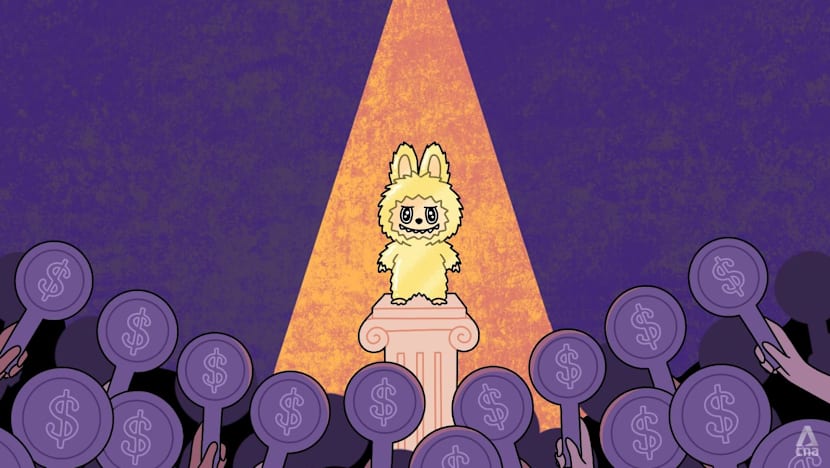Lifestyle
Pop Mart’s Labubu Craze Sparks Global Collecting Phenomenon

The launch of the limited-edition Merlion Labubu doll at the Pop Toy Show in Singapore was met with unexpected chaos, reflecting the fervor surrounding Pop Mart’s collectible toys. Attendees, including 29-year-old project manager Terry Khoo, lined up for hours before dawn at the Marina Bay Sands Expo and Convention Centre, only to have the event cancelled due to a scuffle among fans. Khoo, who arrived at 5 a.m. and estimated 200 to 400 people ahead of him, expressed his disappointment after waiting six hours without acquiring the coveted collectible.
Pop Mart, a company founded in 2010, has surged to prominence in 2024 with its “ugly-cute” Labubu, a plush toy characterized by its rabbit-like ears and mischievous grin. The brand has captured the attention of collectors worldwide, driven by the thrill of unboxing and the limited availability of items. Many, like 41-year-old event stylist Ripple Sim, have invested thousands into their collections, which include over 100 figurines. Sim actively engages her followers through live unboxing videos, further fueling the brand’s popularity.
Collecting Pop Mart toys has become a social activity for many enthusiasts. One civil servant, who chose to remain anonymous, has amassed over 300 figurines worth approximately S$5,000. She noted that the community aspect has transformed her hobby into a shared experience with friends and fellow collectors, allowing for exchanges of tips on finding rare blind-box items.
The success of Pop Mart is reflected in its financial performance, with a reported net profit surge of nearly 400% in August 2023, alongside a revenue increase of 204.4% year-on-year, reaching 13.88 billion yuan (US$1.95 billion). Yet, this meteoric rise has not been without controversy. Critics question the obsession with toys that some perceive as lacking traditional cuteness, leading to debates about consumer behavior and spending priorities. Dr. Joicey Wei, an associate professor at the Singapore University of Social Sciences, characterized the spending on Pop Mart collectibles as irrational to those outside the collector community.
The blind-box format, which conceals the contents until opened, has created a sense of excitement around the products. This model, combined with high-profile endorsements from celebrities like Lisa of Blackpink, has accelerated the brand’s growth. As of August 2024, Pop Mart boasts 571 stores globally, a significant increase from 80 the previous year, and operates 2,597 Robo Shops, automated vending machines selling its toys across various regions.
The toy industry has traditionally been marked by deeply rooted brands with significant cultural heritage. In contrast, Pop Mart’s success has emerged from its ability to create emotional connections devoid of historical narratives. This approach has led to both admiration and skepticism among consumers. Some view the aesthetic and blind-box mechanics as frivolous, while others embrace the community and joy it fosters.
Despite its success, cracks in Pop Mart’s model have begun to appear. Recently, shares plummeted nearly 9%, leading to speculations about the sustainability of its growth. Analysts attribute this volatility to potential regulatory scrutiny and shifting consumer trends. Dr. Shilpa Madan, an assistant professor at Singapore Management University, emphasized the risks associated with consumer behavior and the necessity for continual innovation to maintain interest.
To mitigate these risks, Pop Mart plans to focus on research and development to foster a steady stream of new products. The company’s ability to remain relevant in a rapidly changing market will be crucial as it navigates the challenges ahead. For many collectors, the joy derived from labelling these toys as “tiny pieces of pop art” outweighs the criticisms. As 33-year-old content creator SallyRose Mei noted, her investment in Pop Mart figures brings her happiness amid a complex world, highlighting the emotional value of these collectibles.
As the Labubu craze continues to unfold, its future remains uncertain. While some collectors, like Terry Khoo, ponder the longevity of the trend, others, like Mechie Yu, express concerns about the evolving excitement surrounding the brand. For now, Pop Mart stands at a crossroads, balancing its explosive growth with the realities of consumer sentiment and market dynamics.
-

 Business5 months ago
Business5 months agoKenvue Dismisses CEO Thibaut Mongon as Strategic Review Advances
-

 Lifestyle4 months ago
Lifestyle4 months agoHumanism Camp Engages 250 Youths in Summer Fest 2025
-

 Sports4 months ago
Sports4 months agoDe Minaur Triumphs at Washington Open After Thrilling Comeback
-

 Sports5 months ago
Sports5 months agoTupou and Daugunu Join First Nations Squad for Lions Clash
-

 Top Stories5 months ago
Top Stories5 months agoColombian Senator Miguel Uribe Shows Signs of Recovery After Attack
-

 World5 months ago
World5 months agoASEAN Gears Up for Historic Joint Meeting of Foreign and Economic Ministers
-

 Health4 months ago
Health4 months agoNew Study Challenges Assumptions About Aging and Inflammation
-

 Business5 months ago
Business5 months agoOil Prices Surge Following New EU Sanctions on Russia
-

 Entertainment4 months ago
Entertainment4 months agoDetaşe-Sabah Violin Ensemble Captivates at Gabala Music Festival
-

 Entertainment4 months ago
Entertainment4 months agoBaku Metro Extends Hours for Justin Timberlake Concert
-

 Top Stories5 months ago
Top Stories5 months agoRethinking Singapore’s F&B Regulations Amid Business Closures
-

 Business5 months ago
Business5 months agoU.S. House Approves Stablecoin Bill, Sends to Trump for Signature









